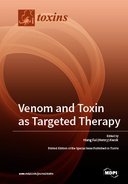Explore

Venom and Toxin as Targeted Therapy
0 Ungluers have
Faved this Work
Login to Fave
Targeted therapy has developed significantly in the last one and half decades, prescribing specific medications for treatment of particular diseases, such as cancer, diabetes, and heart disease. One of the most exciting recent developments in targeted therapies was the isolation of disease-specific molecules from natural resources, such as animal venoms and plant metabolites/toxins, for use as templates for new drug motif designs. In addition, the study of venom proteins/peptides and toxins naturally targeted mammalian receptors and demonstrated high specificity and selectivity towards defined ion channels of cell membranes. Research has also focsed intensely on receptors. The focus of this Special Issue of Toxins addressed the most recent advances using animal venoms, such as frog secretions, bee/ant venoms and plant/fungi toxins, as medicinal therapy. Recent advances in venom/toxin/immunotoxins for targeted cancer therapy and immunotherapy, along with using novel disease-specific venom-based protein/peptide/toxin and currently available FDA-approved drugs for combinationtreatments will be discussed. Finally, we included an overview of select promising toad/snake venom-based peptides/toxins potentially able to address the forthcoming challenges in this field. Both research and review articles proposing novelties or overviews, respectively, were published in this Special Issue after rigorous evaluation and revision by expert peer reviewers.
This book is included in DOAB.
Why read this book? Have your say.
You must be logged in to comment.
Rights Information
Are you the author or publisher of this work? If so, you can claim it as yours by registering as an Unglue.it rights holder.Downloads
This work has been downloaded 279 times via unglue.it ebook links.
- 38 - pdf (CC BY-NC-ND) at Unglue.it.
Keywords
- 2
- 2,4-dinitrochlorobenzene (DNCB)
- 4-dinitrochlorobenzene (DNCB)
- acute lymphoblastic leukemia
- anticancer
- anticancer activity
- antimicrobial activity
- antimicrobial peptide
- antimicrobial peptide (AMP)
- antioxidant enzymes
- antiviral activity
- anuran skin secretion
- Apis mellifera syriaca
- Apoptosis
- atopic dermatitis
- atopic dermatitis (AD)
- B cell non-Hodgkin lymphoma
- bacterial adhesion
- bee venom
- bee venom phospholipase A2 (bvPLA2)
- bicarinalin
- BLF1
- blood vessel formation
- bombesin-related peptide
- Bougainvillea
- bouganin
- bufadienolides
- Cancer
- cancer therapy
- cane toad
- CD206
- CD22
- Chansu
- Clearance
- complement dependent cytotoxicity
- complement system
- decay accelerating factor
- dermaseptin
- disintegrin
- Drug Design
- eIF4A
- frog
- fungal toxin
- gastric cells
- half-life
- Helicobacter pylori
- house dust mite extract (DFE)
- Huachansu
- Immunotherapy
- immunotoxin
- immunotoxins
- in vitro effects
- indolealkylamines
- Inflammation
- LC-ESI-MS
- Malaysian cobras
- mannose receptor
- mantle cell lymphoma
- Mass Spectrometry
- melittin
- membrane attack complex
- Molecular cloning
- Moxetumomab pasudotox
- MYCN
- N. kaouthia
- N. sumatrana
- n/a
- Neuroblastoma
- O. hannah
- obsessive–compulsive disorder (OCD)
- orellanine
- oxidative stress biomarkers
- ribosome-inactivating protein
- ribosome-inactivating proteins
- rRNA N-glycosylase activity
- SEM
- skin inflammation
- smooth muscle
- snake venom
- solid phase extraction
- target therapy
- targeted therapy
- thema EDItEUR::P Mathematics and Science::PS Biology, life sciences
- toad toxins
- VB6-845
- VEGF
Links
DOI: 10.3390/books978-3-03921-190-6Editions


